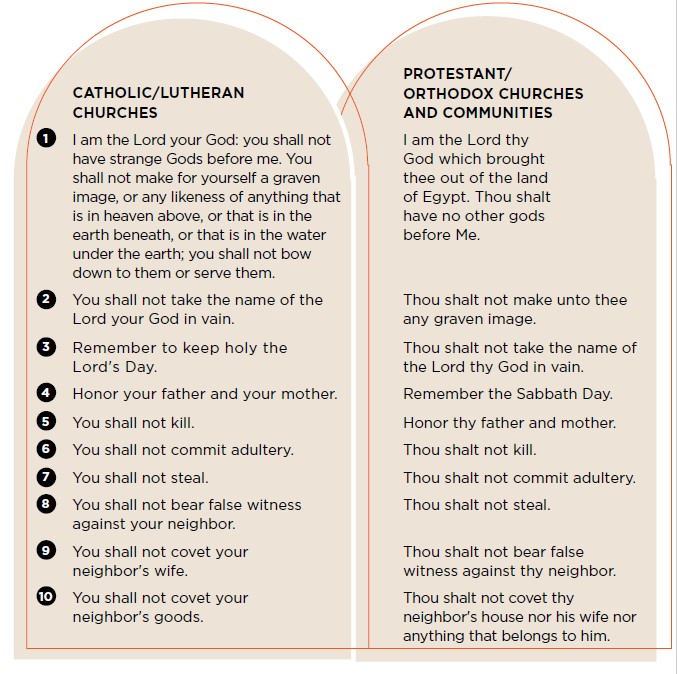Dear Father Joe: Why are the Catholic commandments different from the Protestant ones?

Note: I have a question to tackle in this issue, revolving around Catholic practice vs. Protestant practice. Before I do, I want to make sure you all understand that “Protestant” is a pretty big umbrella. Since it encompasses so many religions, it’s important to note that I’ll be speaking in some sweeping generalizations. With that, let’s dive right in!
Q: Dear Father Joe: My friend told me that Catholics removed a command from the Bible so that we could have statues. She showed me a chart that shocked me: We have the same number of commandments, but they are different. How did this happen?
A: This is a great question and I’m happy to tackle it.
I think the easiest/best thing to do is to recognize that there are two formats for the Ten commandments that are in use within the Christian world. There is the set that Catholics and Lutherans use and the one that many Protestant and Orthodox Churches use.
Let’s put them side by side.(The Catholic/Lutheran version is listed first, followed by the Protestant/Orthodox Churches & Communities.)
1. I am the Lord your God: you shall not have strange Gods before me. You shall not make for yourself a graven
image, or any likeness of anything that is in heaven above, or that is in the earth beneath, or that is in the water
under the earth; you shall not bow down to them or serve them.
1. I am the Lord thy God which brought thee out of the land of Egypt. Thou shalt have no other gods before Me.
2. You shall not take the name of the Lord your God in vain.
2. Thou shalt not make unto thee any graven image.
3. Remember to keep holy the Lord's Day.
3. Thou shalt not take the name of the Lord thy God in vain.
4. Honor your father and your mother.
4. Remember the Sabbath Day.
5. You shall not kill.
5. Honor thy father and mother.
6. You shall not commit adultery.
6. Thou shalt not kill.
7. You shall not steal.
7. Thou shalt not commit adultery.
8. You shall not bear false witness against your neighbor.
8. Thou shalt not steal.
9. You shall not covet your neighbor's wife.
9. Thou shalt not bear false witness against thy neighbor.
10. You shall not covet your neighbor's goods.
10. Thou shalt not covet thy neighbor's house nor his wife nor anything that belongs to him.

So, how did we get to two sets of commandments? Well, if you look at Exodus, God doesn’t number them. He doesn’t even call them “The Ten Commandments." That’s what we call them. Because God didn’t number them, people weighed in with their opinion throughout the years, and in the end, the two most common emerged, which you see today.
In the third century, a guy named Origen created a numbering system that many Protestant and Orthodox churches use today. St. Augustine used a numbering system in the fifth century that Catholics and Lutherans tend to use.
This is how the catechism puts it (2066):
The division and numbering of the Commandments have varied in the course of history. The present catechism follows the division of the Commandments established by St. Augustine, which has become traditional in the Catholic Church. It is also that of the Lutheran confessions. The Greek Fathers worked out a slightly different division, which is found in the Orthodox Churches and Reformed communities.
This is simply a matter of evolved practice. Some ill-informed or ill-intentioned people have looked at the two and implied something heinous is afoot, but that’s just because of sin or ignorance; all the commandments are there in both, we just number them differently.
Enjoy another day in God’s presence!










